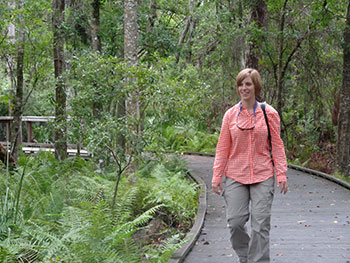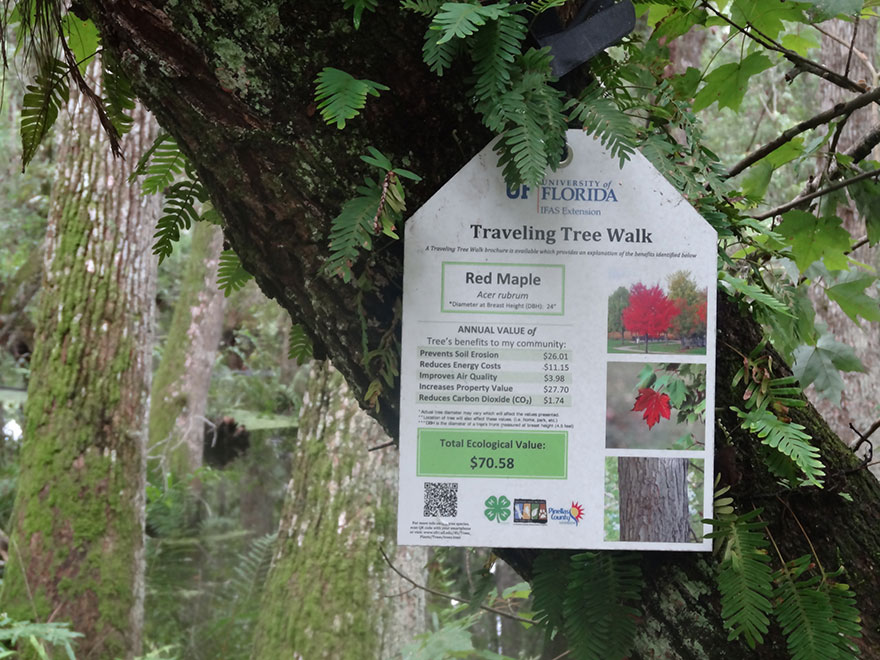 A lot more than most people think, says Lara Miller, natural resource agent for Pinellas County Extension.
A lot more than most people think, says Lara Miller, natural resource agent for Pinellas County Extension.
A University of Florida forestry graduate, Miller was searching for a way to make the average homeowner realize that even one tree can make a significant difference to both their neighborhood ecosystem and their personal wallets. She saw a study detailing how people change their actions when they understand their financial implications and turned it into a hands-on “Traveling Tree Walk.”
“Ecosystem services are benefits that people obtain from natural systems,” she explains. “Placing a monetary value on these services allows economists to compare the value of undeveloped land such as a park or preserve to developed land such as a shopping mall or apartment complex. The idea of assigning a value to ecosystem services is relatively new and still being developed, but it represents a big step for folks trying to conserve lands around the world.”
The Traveling Tree Walk takes that concept a step further to show homeowners how much difference just planting a tree can make – in their pocketbooks, in nearby ecosystems and in their community’s budget.
The Traveling Tree Walk, so called because it can be moved to any park or neighborhood in the county that is interested in it, features “price tags” on trees that detail their benefits. For instance, a 42-inch live oak provides annual benefits worth $222.84 per year, including “income” of:
- $108.62 in preventing soil erosion and reducing the impact of stormwater on local estuaries. Trees catch rainfall in their leaves, branches and bark, slowing the speed of rainfall and allowing it to seep into the soil.
- $63.34 in increased property values because homebuyers are willing to pay more for a home with trees than one without.
- $38.18 in energy costs as the tree shades your home in the summer and block cold winter winds.
- $7.57 in carbon dioxide reductions because trees sequester climate-changing CO2 in their trunks, stems and leaves. They continue to hold on to the CO2 even after they’ve been harvested for construction.
- $5.13 in improved air quality because trees absorb air pollution through their leaves, intercept particles such as dust, ash and smoke, and release oxygen we need to breathe.
Along with the live oak, the Traveling Tree Walk includes specific data on other common Florida trees including the laurel oak (annual ecological value of $149.98), water oak (annual value of $130.41), bald cypress (annual value $91.48), red maple (annual value $70.58) and longleaf pine (annual value $36.87).
Although the program highlights ecological value, it doesn’t compute value to wildlife. “Longleaf pines are a favorite spot for nesting bald eagles, so obviously that tree would have much more value,” Miller said. Additionally, she emphasizes that the value of the tree is set up as an annual impact rather than a lifetime impact. “A tree like a live oak with a lifespan of more than 100 years is clearly an outstanding investment for both the homeowner and the neighborhood.”
Click on the images below to view a larger image of each price tag. You may also download a printable pdf file of all price tags or download printable pdf files of each tree: Bald Cypress, Laurel Oak, Live Oak, Longleaf Pine, Red Maple, Water Oak.
Calculate the benefits of almost any tree at www.treebenefits.com.
The Traveling Tree Walk made its debut at Brooker Creek Park where Miller is based but can be scheduled to visit any park or neighborhood in Pinellas County. Miller is also working with other county extension offices to expand across the state and perhaps the nation.
[su_divider]